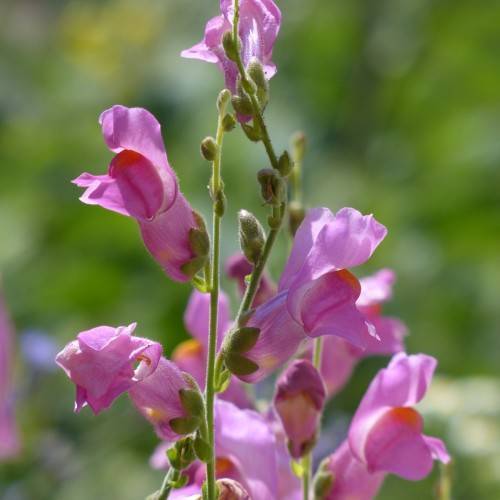
snapdragon
Antirrhinum 'Dulcinea's Heart'
Cycle:
Herbaceous Perennial
Watering:
Average
Hardiness Zone:
5 - 8
Flowers:
Flowers
Sun:
Full sun
Leaf:
Yes
Growth Rate:
High
Maintenance:
Moderate
Care Level:
Medium
watering
Snapdragons (Antirrhinum 'Dulcinea's Heart') need to be kept moist but not soggy, particularly during the warmer months. Water deeply and thoroughly whenever the top of the soil becomes dry. For container plants, check the soil every day or 2 and water when the top inch or 2 of soil is dry. To save water, you can also group several plants together and water them at the same time. In cooler months, water less often, allowing the top inch or 2 of soil to dry out between waterings. Be sure to empty any saucers after watering as snapdragons are prone to root rot if overwatered.
sunlight
Snapdragon (Antirrhinum 'Dulcinea's Heart') plants prefer full sun, which means 6 to 8 hours of direct sunlight each day. When given direct sunlight, Snapdragons will display vibrant colors, produce more flowers, and grow fuller. During the spring and summer months, your Snapdragon should receive its full dose of sunlight each day. However, during the cooler months, you can move your Snapdragon to a sunny window and that should be enough to keep it happy.
pruning
Snapdragons (Antirrhinum 'Dulcinea's Heart') should be pruned in late winter or early spring, when the plant is still relatively dormant. To prune, cut any dead or damaged stems off at the base. Additionally, prune any weak or spindly stems that detract from the plants structure and overall fullness. When pruning, always make sure to use a clean, sharp pair of pruning shears to ensure a clean, even cut. Pruning should be done only moderately in order to prevent over-stimulating the plant. Too much pruning can reduce flowering and may even compromise the plant's health. A light trimming every year should be enough to maintain the plant and encourage healthy flower growth.
FAQ
Is it easy to grow dog flower plants?
No, growing dog flower plants is not easy. These plants require a specific soil and climate conditions to thrive, such as full sun and well-drained soil. Dog flowers need ample amounts of water, but grown in overly wet conditions, the roots may rot, resulting in an unhealthy plant. Additionally, these plants must be pruned and fertilized regularly in order to encourage healthy new growth and to maintain the desired shape. Lastly, dog flowers are susceptible to a variety of diseases and pests, so careful monitoring of plants is necessary.
Do dog flowers bloom all year round?
No, dog flowers do not bloom all year round. Dog flowers are a type of plant that is perennial, meaning they grow and bloom in the spring and summer months and then go dormant in the fall and winter. Depending on what species of dog flower you have, blooms may appear again in early spring, or the plant may take several years before it blossoms again.
Are dog flowers easy to propagate?
No, dog flowers, also known as African violets, are not easy to propagate. African violets are hard to propagate from cuttings as the leaves can be damaged, and their small root systems can be difficult to work with. Additionally, these flowers are unlikely to produce blooms if propagated from leaf cuttings. However, African violets can be propagated from seed, although it can be quite challenging, especially for the novice gardener.
Should dog flowers be grown from seeds or cuttings?
Whether or not you should grow dog flowers from seeds of cuttings depends on the variety of dog flower you wish to grow. Some dog flowers do not come true from seed, meaning that the flowers that grow from the seeds will not necessarily be the same as the flower the seed was taken from. If the exact same flower is desired, then cuttings should be used to propagate the plant. However, if you are looking for an interesting mix of colors and varieties, then growing dog flowers from seed may be the way to go.
Is the dog flower plant endangered?
No, the dog flower plant is not endangered. The plant is native to southern New Caledonia, where it can be found in open grasslands, but it is not considered threatened or vulnerable in any way. The plant is very common in the area and the current population trend is stable. As with any species, human activity around the planet can be a threat to the long-term survival of the dog flower plant, which is why conservation initiatives for the area are important.
Is the dog flower plant drought-tolerant?
No, the dog flower plant is not drought-tolerant. Instead, it needs regular watering and full sunlight to thrive and flower. It grows best in well-drained soil, and should have fertilizer applied twice a year. Plus, it is not particularly heat-tolerant and prefers cooler temperatures.
